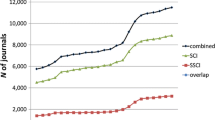Abstract
The time distributions of references given by five leading journals in each of seven life science disciplines revealed that the decrease in the frequency of references is faster in the early years (5–10 years) than later. The rate of decrease is in good correlation with the 3 and 4 year-old references per article values, with the discipline impact factor sums and with the ratio of the 3-year-old references to the 4-year-old ones. The results are discussed as evidence supportingPrice's immediacy factor, i.e. the fall of citations in time does not mean obsolescence.
Similar content being viewed by others
References
R. E. BURTON, R. W. KEBLER, The “Half-life” of Some Scientific and Technical Literatures,American Documentation, 11 (1960) 18–22.
D. PRICE, Networks of Scientific Papers,Science 149 (1965) 510–515.
J. MARTON, Causes of Low and High Citation Potentials in Science: Citation Analysis of Biochemistry and Plant Physiology Journals,J. Am. Soc. Inform. Sci., 34 (1983) 244–246.
A. SANDISON, Densities of Use, and Absence of Obsolescence, in Physics Journals at MIT,J. Am. Soc. Inform. Sci., 25 (1974) 172–182.
M. V. SULLIVAN, B. VADEBONCOEUR, N. SHIOTANI, P. STANGL, Obsolescence in Biomedical Journals: not an Artifact of Literature Growth,Library Res., 2 (1980) 29–46.
R. H. PARKER Bibliometric Models for Management of an Information store. II. Use as a Function of Age of Material,J. Am. Soc. Inform. Sci., 33 (1982) 129–133.
W. UMSTÄTTER, M. REHM, Z. DOROGI Die Halbwertszeit in der naturwissenschaftlichen Literatur,Nachr. f. Dokum., 33 (1982) 50–52.
M. B. LINE, A. SANDISON “Obsolescence” and Changes in the Use of Literature with Time,J. Doc., 30 (1974) 283–350.
D. K. GAPEN, S. P. MILNER, ObsolescenceLibrary Trends, Summer 1981, 107–124.
H. M. ARTUS, “Halbwertzeit wissenschaftlichen Literatur” — Naturgesetz oder Forschungsartefakt?Nachr. f. Dokum., 34 (1983) 79–86.
M. B. LINE, The “Half life” of Periodical Literature: Apparent and Real Obsolescence,J. Doc., 26 (1970) 46–54.
T. BRAUN, W. S. LYON, E. BUJDOSÓ Literature Growth and Decay: an Activation Analysis Resume,Analytical Chemistry, 49 (1977) 682A-688A.
B. C. GRIFFITH, P. N. SERVI, A. L. ANKER, M. C. DROTT, The Aging of Scientific Literature: a Citation Analysis,J. Doc., 35 (1979) 179–196.
D. PRICE, Citation Measures of Hard Science, Soft Science, Technology and Nonscience, in:Communication Among Scientists and Engineers, Ed. C. E. NELSON, D. K. POLLOCK. Heath Lexington Books, Lexington, 1971. 4–23.
E. GARFIELD, The Number of Biochemical Articles is Growing, but why Also the Number of References per Article?Current Contents (1980)11, 5–16.
J. MARTON, Changes in the Time Distribution of Biochemical Article References from 1962 to 1977,Scientometrics, 3 (1981) 397–400.
Author information
Authors and Affiliations
Rights and permissions
About this article
Cite this article
Marton, J. Obsolescence or immediacy? Evidence supporting Price's hypothesis. Scientometrics 7, 145–153 (1985). https://doi.org/10.1007/BF02017142
Received:
Issue Date:
DOI: https://doi.org/10.1007/BF02017142




